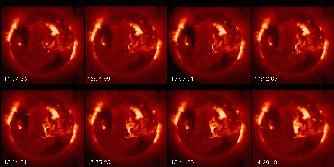
Coronal dimming in X-rays and EUV is often discussed in the context of CMEs. In a disk event, we sometimes see a pair of dimming regions (typically in the 1996-1997 period, largely by SOHO/EIT), and this has aroused creative imagination in some of our colleagues, who identify the twin dimming areas as foot-points of the flux rope that may be a central part of the CME. For flare-associated CMEs, apart from a small number of exceptions, observations suggest that dimming starts with the onset of the flare and maximizes later. In this nugget, we report on another twin-dimming event, which occurred close to a small active region AR 9364. The following figure (click to enlarge) shows a sequence of SXT images. The location of dimming is near disk center, slightly toward south. The second image at 12:54:59 clearly shows dimming in two areas, aligned almost north-south.

In the images after 13:24:51, the northern dimming is obscured by brightenings. But these brightenings are very small and may not be qualified as a flare. See a GOES plot below, where the dashed line indicates the time of the first SXT image in which we see the twin dimming.
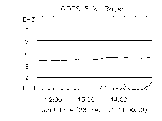
As expected, this dimming seems to be correlated with a CME, which may be called a partial halo. Most people would regard this as a flareless CME, expression that is used to show that one man's oxymoron may be another man's paradigm. A LASCO difference image is shown below. The appearance of the CME around the west limb indicates that it intersected field lines that were well connected to Earth. However, there were no major particle events, indicative of the absence of interplanetary shocks. There was a period during 4-5 March, in which the Kp index became 4-5, but the relation to this event is not clear.
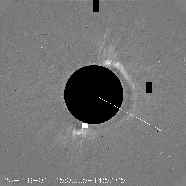
The line in the above figure from the center to the direction of 4 o'clock is where we measured the speed of the CME. The following figure is a usual height-time plot. The regression line (assuming constant speed) shows that the speed is 287 km/s and the time at 0.19 Rsun (corresponding to 1 Rsun at the position of the dimming) is 13:15 UT.
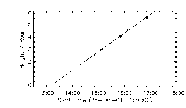
The dimming was seen much earlier than that. Why is this inconsistency? One obvious factor is a huge extrapolation needed to estimate the time the CME left the Sun. If the ejection was radial (how do we know?), the proximity of the dimming region to disk center means that the CME was already at the height of 10 Rsun so that it emerged above the LASCO occulting disk of 2 Rsun. There is no guarantee that there was no acceleration or deceleration in this range of the CME's trajectory. The height-time approach could be very tricky for events away from the limb. Those events are affected more seriously by the trivial fact that a CME is not a 2-d object constrained in the plane of the sky. Another possibility may be that the dimming accounts for only small part of the CME, say that of the directions of 1 o'clock and 7 o'clock, and that the larger part of the halo is due to a minor flaring around 13:30 UT. But this is a wild speculation.
We are running a campaign to observe S-shaped structures, frequently referred to as "sigmoids", as a target of opportunity. This is largely because sigmoids have higher probabilities to lead to major eruptions. Indeed, the sigmoid-to-eruption pattern has appeared in these nuggets numerous times (see for example,
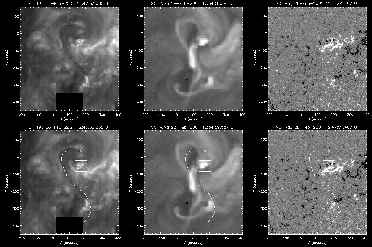
The lower part of the filament was moving slowly to right, presumably corresponding to higher altitudes, until the 12:47 UT image, and it is no longer visible in the next image at 13:25 UT. The S-shape structure is absent in the SXT image at 11:57 UT.
This event shows another example of twin dimming correlated with a (partial) halo CME, but their relation is not clear. It is possible that the observed CME consists of two parts, and that only the non-halo part is due to the eruption of a flux rope (delineated by a filament) as signified by the twin dimming. The vigorous flux emergence west of the filament may have destabilized it. The S-shaped structure was not seen in SXT images prior to dimming. It is not clear whether we should have seen it if we had had better data coverage. The S-shaped structure seen after the dimming started does not align with the S-shaped dark filament in EUV. Speaking about the possible signatures of filaments in SXT data, we are keenly aware that they have not been systematically studied. We tend to conclude things based primarily on what we easily see in data at hand. But something nearly invisible in one's own data but visible in others' data may carry important information. Hence, the importance of multi-wavelength studies. We hope that the SOHO campaigns always involve us, since SXT data can provide valuable information on high-temperature corona, which the imaging instruments on SOHO can hardly see.